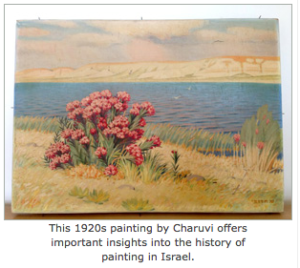 E.D. from the LA area sends me a photo of this paintings by Charuvi Schmuel (1897-1965) from the 1920’s, of what I believe is an image of Kinneret, an archaeological site and biblical city on the Southwestern shore of the Sea of Galilee in Israel. Lake Kinneret (Sea of Galilee) is Israel’s largest freshwater lake. The story of this painting is the story of painting in modern Israel in general.
E.D. from the LA area sends me a photo of this paintings by Charuvi Schmuel (1897-1965) from the 1920’s, of what I believe is an image of Kinneret, an archaeological site and biblical city on the Southwestern shore of the Sea of Galilee in Israel. Lake Kinneret (Sea of Galilee) is Israel’s largest freshwater lake. The story of this painting is the story of painting in modern Israel in general.
You will remember the famous line in Ben Hur when Hur’s mother states, “Israel has had no artists,” by which she means, although Israel has had sculptors, a law given by Moses may be taken to proscribe painting: “Thou shalt not make unto thee any graven image.” No one argues that this had a significant impact on painting in pre-20th century Israel, until a young artist who loved art as a talented painter, Shlomo-Zahlman Dov Baruch (1866-1932) (Boris Schatz), founded The Bezalel Academy of Art, Architecture and Design in Jerusalem in 1906. Still an institution for artists today, the artist of E.D.’s painting Charuvi was Schatz’ disciple.
In 1903, Schatz approached the Seventh Zionist Congress in Basel with the idea of a Talmudic College for Art in Israel: the Congress accepted, and in 1906 Schatz left Bulgaria for Israel, founding Bezalel. Craftwork was an important philosophical element in his curricula, and soon talented student artists had produced enough objects that Schatz packed them up for exhibit tours in the great cities of the early 20th century. Prof. Boris Schatz of Palestine became known for an artistic revival of Hebrew culture in Israel.
E.D.’s painter, Charuvi Shmuel, was born in Ukraine in 1897; studying art in Odessa, he witnessed one of Prof. Schatz’ tours where Bezalel students from Israel organized a show and lecture. Charuvi was 16 and entranced by the Zionist ideas he saw and heard. Charuvi immigrated to Israel, joining the Bezalel Academy at the age of 17, eagerly studying all the applied arts, but falling in line with painting “to draw the Israeli landscape as I had imaged it, being far away.” Charuvi in later life was credited as one of the founders of “Jerusalem Realism” in painting.
I hear echoes of Chaim Potok’s My Name is Asher Lev in the lives of Schatz and his student Charuvi, for whom a life in painting meant a different struggle than for other artists. Yet the Bezalel School, which E.D.’s painting exemplifies, became a landmark for the artistic and economic development of Schatz’s Palestine. Many American Jews were supporters, for example, James N. Rosenberg, a lawyer of the 1920’s and VP of the United Jewish Campaign convened a Bezalel Arts & Crafts Exhibition at the Grand Central Palace in NY in January of 1925. Americans purchased carvings, rugs, weavings, paintings, sculptures, fabrics, wicker furniture, lithographs, and works in brass, silver and copper. The Modern Zionist Movement, or so people called it in the 1920’s, saw the continued growth of Bezalel, the first Jewish art school. The broad range of artworks, such as those acquired abroad by donors and supporters, formed the core of the Bezalel museum, which became the basis for the Israel Museum. Perhaps the wide-ranging scope of Schatz’s philosophical definition of fine art can be credited with present-day Israel’s diverse craft traditions.
Boris Schatz, born in Lithuania in 1866 into a family of rabbinical lineage, desired to be a painter while in yeshiva (Talmudic College) pursuing religious studies. In his autobiography, he writes “I tried not to think about things that cause one to sin (but) from (yeshiva) on I began drawing and loving human portraits.” He left yeshiva to sculpt in Warsaw; wanting more, he left for the Cormorn Academy in Paris, where he made tuition by boxing and wrestling. Prince Ferdinand appointed him court sculptor of the Bulgarian Kingdom where he founded the Royal Academy of Art in Sofia. A success, he dreamed of a school in Israel to be called Bezalel after Bezalel Ben Uri Ben Hur, from the Yehuda tribe, the first artist of the Bible.
Schatz later said: “I looked upon art as a temple and artists as its priests. I dreamed that I should become a high priest in the service of sacred art, that I would teach mankind the ideal of the ‘great and beautiful.’” During his rather unorthodox life, Dr. Schatz trained many well-known Israeli artists like E.D.’s painter Charuvi. E.D.’s little oil on canvas from the 1920’s is worth $3,000 because o the important story it tells of painting in Israel.